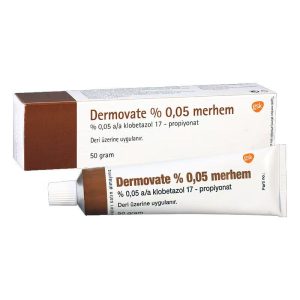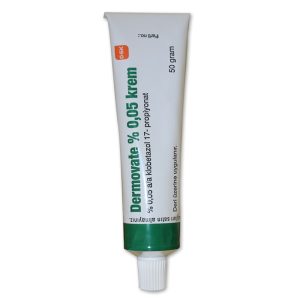Table of Content
- Composition – The active and inactive ingredients.
- Indications – Conditions treated (e.g., psoriasis, lichen planus).
- Dosage and Administration – Guidelines for application, frequency, and special instructions for specific patient groups.
- Contraindications – Situations where the product should not be used (e.g., untreated infections, rosacea).
- Warnings and Precautions – Risks such as systemic absorption, visual disturbances, and specific concerns for children and elderly.
- Pharmacological Properties – Information on the drug’s mechanism of action, absorption, metabolism, and elimination.
- Adverse Reactions – Side effects categorized by frequency.
- Overdose – Symptoms and treatment for overdose scenarios.
Composition: Active and Inactive Ingredients
Active Ingredient:
- Clobetasol Propionate: 0.05% w/w
Inactive Ingredients:
For Dermovate Cream:
- Glyceryl Monostearate
- Cetostearyl Alcohol
- Chlorocresol
- Sodium Citrate
- Citric Acid (Monohydrate)
- Purified Water
- Arlacel 165
- Beeswax Substitute 6621
- Propylene Glycol
For Dermovate Ointment:
- Propylene Glycol
- White Soft Paraffin
- Sorbitan Sesquioleate
These formulations are tailored to their respective forms, with the cream focusing on moist or weeping surfaces and the ointment designed for dry, lichenified, or scaly lesions.
Indications: Conditions Treated
Dermovate is a very potent topical corticosteroid indicated for adults, elderly, and children over 1 year of age for the relief of inflammatory and pruritic manifestations of steroid-responsive dermatoses.
Conditions Treated:
Psoriasis
- Excluding widespread plaque psoriasis.
Recalcitrant Dermatoses
- Chronic skin conditions that are resistant to less potent treatments.
Lichen Planus
- A condition characterized by inflammatory skin lesions.
Discoid Lupus Erythematosus
- A chronic autoimmune condition affecting the skin.
Other Steroid-Responsive Conditions
- Skin disorders that do not respond satisfactorily to less potent corticosteroids.
Dermovate is prescribed when less potent corticosteroids fail to deliver satisfactory results, ensuring controlled management of these severe skin conditions.
Dosage and Administration
Pharmaceutical Forms:
- Cream: Best suited for moist or weeping surfaces.
- Ointment: Ideal for dry, lichenified, or scaly lesions.
General Guidelines:
- Application Method:
Apply a thin layer and gently rub it into the affected area. Use only enough to cover the area completely. - Frequency:
Apply once or twice daily until improvement occurs (up to a maximum of 4 weeks). - Absorption:
Allow adequate time for the product to absorb before applying an emollient. - Course Duration:
- Treatment should not exceed 4 weeks.
- If continuous treatment is necessary, switch to a less potent preparation.
Specific Instructions:
1. For Resistant Lesions:
- Enhancement Method:
- Occlude the treatment area with a polythene film overnight to enhance effect.
- Continue non-occluded treatment after improvement.
2. Atopic Dermatitis (Eczema):
- Gradually discontinue therapy after achieving control.
- Continue emollient use as maintenance therapy.
- Avoid abrupt discontinuation to prevent rebound symptoms.
3. Recalcitrant Dermatoses:
- Intermittent Dosing:
After successful treatment of an acute episode, consider twice-weekly application to previously affected sites to reduce relapse risk. - Combine with routine daily use of emollients.
4. Children (Over 1 Year):
- Contraindication:
Not recommended for children under 1 year. - Use minimal amounts for the shortest duration possible to achieve therapeutic benefit.
- Avoid long-term continuous therapy in children under 12 years.
5. Elderly Patients:
- Use the smallest effective quantity for the shortest duration due to the potential for delayed metabolism and elimination.
6. Patients with Renal or Hepatic Impairment:
- Limit application to minimize systemic absorption, especially when treating large areas or using prolonged therapy.
Maximum Dosage:
- Weekly Limit:
Do not exceed 50 g per week to avoid systemic effects.
Treatment Reevaluation:
- If no improvement occurs within 2-4 weeks, the diagnosis and treatment should be reassessed.
- For exacerbations, short repeated courses of Dermovate may be used.
Contraindications: Situations Where Dermovate Should Not Be Used
Dermovate is contraindicated in the following situations due to the risk of worsening conditions or adverse effects:
1. Untreated Cutaneous Infections
- Bacterial, fungal, or viral skin infections must be treated before applying Dermovate.
2. Specific Skin Conditions
- Rosacea:
Not suitable for treating this chronic facial skin disorder. - Acne Vulgaris:
Should not be used as it may exacerbate the condition. - Perioral Dermatitis:
Contraindicated as it can aggravate this inflammatory condition.
3. Pruritus Without Inflammation
- Should not be used for itching when no signs of inflammation are present.
4. Perianal and Genital Pruritus
- Inappropriate for itching in the anal or genital areas without accompanying inflammation.
5. Dermatoses in Children Under 1 Year
- Contraindicated for any dermatoses in this age group, including dermatitis.
6. Hypersensitivity
- Known Allergies:
Patients with a history of hypersensitivity to corticosteroids or any of Dermovate’s excipients should avoid use.
Warnings and Precautions
1. Systemic Absorption Risks
- Manifestations:
- Hypercortisolism (Cushing’s Syndrome): Symptoms include moon face, central obesity, and hypertension.
- Reversible Hypothalamic-Pituitary-Adrenal (HPA) Axis Suppression: May lead to glucocorticoid insufficiency.
- Risk Factors for Increased Absorption:
- Use of potent steroids like Dermovate.
- Prolonged exposure or application over large surface areas.
- Use on occluded areas (e.g., under dressings, in infants using nappies).
- Application on thin or broken skin (e.g., face or damaged areas).
- Increased hydration of the skin (e.g., in intertriginous areas).
2. Visual Disturbances
- Reported Conditions:
- Blurred vision.
- Cataracts.
- Glaucoma.
- Central serous chorioretinopathy (CSCR).
- Action:
If visual disturbances occur, evaluate for underlying causes.
3. Children
- Adverse Effects:
- More susceptible to local and systemic side effects due to a higher skin surface area to body weight ratio.
- Potential for adrenal suppression and atrophic skin changes.
- Recommendations:
- Avoid long-term continuous therapy in children under 12 years.
- Use minimal effective amounts for the shortest duration.
- Limit treatment to a few days and review weekly.
4. Elderly Patients
- Considerations:
- Reduced hepatic or renal function may delay systemic clearance if absorbed.
- Use the smallest effective quantity for the shortest duration to minimize risks.
5. Infection Risks
- Occlusion:
- Warm, moist conditions under dressings or in skin folds can encourage bacterial growth.
- Cleanse the skin before applying new dressings.
- Spread of Infection:
- Discontinue Dermovate and treat the infection appropriately if it spreads.
6. Use in Psoriasis
- Risks:
- Rebound relapses.
- Development of tolerance.
- Risk of generalized pustular psoriasis.
- Local or systemic toxicity due to impaired barrier function.
- Action:
Use with caution under close supervision.
7. Chronic Leg Ulcers
- Considerations:
- Topical corticosteroids may increase the risk of local hypersensitivity reactions and infection.
8. Application to the Face
- Risks:
- Increased susceptibility to atrophic changes.
- If necessary, limit treatment duration to a few days.
9. Application to the Eyelids
- Risks:
- Accidental entry into the eyes may cause cataracts or glaucoma.
- Ensure careful application to avoid contact with the eyes.
10. Fire Hazard
- Product Contains Paraffin:
- Contact with clothing, bedding, or dressings can pose a serious fire risk.
- Instruct patients to avoid open flames and wash fabric to reduce product build-up.
Pharmacological Properties
1. Pharmacodynamics
- ATC Code:
- D07AD: Corticosteroids, very potent (Group IV).
- Mechanism of Action:
Dermovate (Clobetasol Propionate) is a very potent topical corticosteroid with anti-inflammatory, antipruritic, and vasoconstrictive properties. Its action is mediated through:- Inhibition of Late-Phase Allergic Reactions:
- Reduces mast cell density.
- Decreases eosinophil chemotaxis and activation.
- Suppresses cytokine production from lymphocytes, monocytes, mast cells, and eosinophils.
- Inhibits arachidonic acid metabolism.
- Inhibition of Late-Phase Allergic Reactions:
- Pharmacodynamic Effects:
- Reduces inflammation and itching in skin conditions.
- Constricts blood vessels, decreasing redness and swelling.
2. Pharmacokinetics
a. Absorption:
- From Intact Skin:
Systemic absorption of Clobetasol Propionate varies based on:- Skin integrity.
- The formulation used (cream or ointment).
- Application to inflamed or diseased skin, which may increase absorption.
- Occlusion or hydration of the skin, which enhances absorption.
- Clinical Observations:
- Healthy Skin:
- Mean peak plasma concentration: 0.63 nanograms/mL (8 hours post-second application of 30 g ointment).
- Inflamed Skin (Psoriasis or Eczema):
- Mean peak plasma concentrations: 2.3 nanograms/mL (psoriasis) and 4.6 nanograms/mL (eczema) within 3 hours after a single 25 g application.
- Healthy Skin:
b. Distribution:
- Systemic Levels:
Circulating levels of Clobetasol Propionate are typically below detection limits.- Pharmacodynamic endpoints are used for systemic exposure evaluation.
c. Metabolism:
- Primary Site:
Liver. - Pathways:
Topical corticosteroids follow similar metabolic pathways to systemically administered corticosteroids.
d. Elimination:
- Primary Route:
Excreted via the kidneys. - Secondary Route:
Some corticosteroids and their metabolites are also excreted in the bile.
3. Clinical Relevance
Understanding the pharmacological properties is crucial for:
- Determining the appropriate formulation (cream or ointment) based on skin condition.
- Minimizing systemic absorption and associated risks.
- Optimizing treatment outcomes through controlled application and duration.
Adverse Reactions
Adverse drug reactions (ADRs) to Dermovate (Clobetasol Propionate) are categorized below based on the MedDRA System Organ Class and frequency classifications:
Frequency Classifications:
- Very Common: ≥ 1/10
- Common: ≥ 1/100 and < 1/10
- Uncommon: ≥ 1/1,000 and < 1/100
- Rare: ≥ 1/10,000 and < 1/1,000
- Very Rare: < 1/10,000 (including isolated reports)
1. Infections and Infestations
- Very Rare: Opportunistic infections.
2. Immune System Disorders
- Very Rare: Local hypersensitivity reactions.
3. Endocrine Disorders
- Very Rare:
- Hypothalamic-pituitary-adrenal (HPA) axis suppression.
- Cushingoid features (e.g., moon face, central obesity).
- Delayed weight gain or growth retardation in children.
- Osteoporosis.
- Hyperglycemia/glucosuria.
- Hypertension.
- Increased weight or obesity.
- Decreased endogenous cortisol levels.
- Alopecia or brittle hair (trichorrhexis).
4. Eye Disorders
- Very Rare:
- Cataracts.
- Central serous chorioretinopathy.
- Glaucoma.
5. Skin and Subcutaneous Tissue Disorders
- Common:
- Pruritus.
- Local skin burning or pain.
- Uncommon:
- Skin atrophy.
- Striae (stretch marks).
- Telangiectasia (visible blood vessels).
- Very Rare:
- Skin thinning and wrinkling.
- Dryness and pigmentation changes.
- Hypertrichosis (excessive hair growth).
- Worsening of underlying conditions.
- Allergic contact dermatitis.
- Pustular psoriasis.
- Erythema, rash, or urticaria (hives).
- Acneiform eruptions.
6. General Disorders and Administration Site Conditions
- Very Rare:
- Application site irritation or pain.
Special Notes on Skin Features:
- Atrophic Changes:
- These are secondary to local and/or systemic effects of HPA axis suppression.
Overdose
1. Symptoms of Overdose
Topical Overdose:
- Systemic absorption of Dermovate (Clobetasol Propionate) from prolonged or excessive application may lead to:
- Features of Hypercortisolism (Cushing’s Syndrome), including:
- Moon face.
- Central obesity.
- Hypertension.
- Hyperglycemia.
- Hypothalamic-Pituitary-Adrenal (HPA) Axis Suppression, resulting in:
- Glucocorticoid insufficiency.
- Features of Hypercortisolism (Cushing’s Syndrome), including:
- Acute overdose is unlikely to occur due to the topical nature of the product.
- Systemic absorption of Dermovate (Clobetasol Propionate) from prolonged or excessive application may lead to:
Chronic Overdose or Misuse:
- Prolonged use or application to large areas can lead to systemic effects consistent with corticosteroid overexposure.
2. Treatment of Overdose
Gradual Withdrawal:
- To minimize the risk of glucocorticoid insufficiency:
- Reduce the frequency of application.
- Substitute with a less potent corticosteroid.
- To minimize the risk of glucocorticoid insufficiency:
Supportive Care:
- Manage symptoms as clinically indicated.
Poison Control:
- Consult the national poison center for guidance on overdose management, if available.
Clinical Considerations:
- Prevention:
- Adhere to prescribed dosage and duration to avoid overdose risks.
- Limit weekly use to a maximum of 50 g.
- Monitoring:
- Patients with prolonged or extensive use should be monitored for systemic corticosteroid effects.
-
Dermovate
Dermovate Ointment
$63.50Original price was: $63.50.$37.99Current price is: $37.99. Add to cart -
Dermovate
Dermovate Cream
$63.50Original price was: $63.50.$37.99Current price is: $37.99. Add to cart


